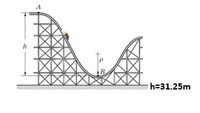
Elements Of Electromagnetics
7th Edition
ISBN: 9780190698614
Author: Sadiku, Matthew N. O.
Publisher: Oxford University Press
expand_more
expand_more
format_list_bulleted
Concept explainers
Question
Determine the required height h of the roller coaster so that when it is essentially at rest at the crest of the hill A it will reach a speed of 25 m/s when it comes to the bottom B.

Transcribed Image Text:A
B.
h=31.25m
Expert Solution
This question has been solved!
Explore an expertly crafted, step-by-step solution for a thorough understanding of key concepts.
This is a popular solution
Trending nowThis is a popular solution!
Step by stepSolved in 2 steps with 2 images

Knowledge Booster
Learn more about
Need a deep-dive on the concept behind this application? Look no further. Learn more about this topic, mechanical-engineering and related others by exploring similar questions and additional content below.Similar questions
- The roller coaster car has a mass of 700 kg, including its passenger. If it starts from the top of the hill A with a speed v A = 3 m/s, determine the minimum height h of the hill crest so that the car travels around the inside loops without leaving the track. Neglect friction, the mass of the wheels, and the size of the car. What is the normal reaction on the car when the car is at B1. find the Max g-force on passenger, bank angle2. the force required to slow down the motion and the time the force is applied must be determined to bring the coaster to rest.3. The maximum G-load experienced by a person should be no more than 5 garrow_forwardThe motor, M, pulls on the cable with a force F = (101² + 300)N, where t is in seconds. If the 100 kg crate is originally at rest at 1 = 0, determine its speed when t = 4 s. Hint: First find the time needed to begin lifting the crate.arrow_forwardThe small body has a speed va = 4.0 m/s at point A. Neglecting friction, determine its speed at point B after it has risen 0.68 m. Is knowledge of the shape of the track necessary? 0.68 m 4.0 m/s B Answer: VB = i m/sarrow_forward
- The ball with a mass of 5 kg is attached to the rod (with negligible mass), which rotates about O in the horizontal plane. A couple moment M = 0.5 t2 N-m is applied to the system, where t is in seconds. Determine the speed of the ball at the instant t = 10 s starting from rest.arrow_forwardThe rocket is in a free-flight elliptical orbit about the earth such that e = 0.76 as shown. Determine its speed when it is at point A. Also determine the sudden change in speed the rocket must experience at B in order to travel in free flight along the orbit indicated by the dashed path. B 9 Mm -8 Mm 5 Mmarrow_forwardThe 64.4-lb slider moves in the vertical plane on a smooth rail. The spring with k = 800 lb/ft is unstretched with the slider at point B. If the slider is released from rest at point A, what is the speed at point C? The slider can be approximated as a particle. 인 it woll 3 ft C abert --www- A B 3 ftarrow_forward
- The forked rod is used to move the smooth 3 lb particle around the horizontal path in the shape of a limaçon, r=(2+cose) ft. If 0=(0.5t2) rad, where t is in seconds, determine the force which the rod exerts on the particle at the instant t=1 s. The fork and path contact the particle on only one side.arrow_forward5. The 8-kg smooth collar has a speed of 5 m/s when it is at s = 0. Determine the maximum distance s it travels before it stops momentarily. The spring has an unstretched length of 2 m. -1.5 m- -3 m/s k = 100 N/marrow_forwardThe 214000-lb space-shuttle orbiter touches down at about 222 mi/hr. At 182 mi/hr its drag parachute deploys. At 40 mi/hr, the chute is jettisoned from the orbiter. If the deceleration in feet per second squared during the time that the chute is deployed is -0.000200v2 (speed v in feet per second), determine the corresponding distance s traveled by the orbiter. Assume no braking from its wheel brakes. Answer: s = i ftarrow_forward
arrow_back_ios
arrow_forward_ios
Recommended textbooks for you
 Elements Of ElectromagneticsMechanical EngineeringISBN:9780190698614Author:Sadiku, Matthew N. O.Publisher:Oxford University Press
Elements Of ElectromagneticsMechanical EngineeringISBN:9780190698614Author:Sadiku, Matthew N. O.Publisher:Oxford University Press Mechanics of Materials (10th Edition)Mechanical EngineeringISBN:9780134319650Author:Russell C. HibbelerPublisher:PEARSON
Mechanics of Materials (10th Edition)Mechanical EngineeringISBN:9780134319650Author:Russell C. HibbelerPublisher:PEARSON Thermodynamics: An Engineering ApproachMechanical EngineeringISBN:9781259822674Author:Yunus A. Cengel Dr., Michael A. BolesPublisher:McGraw-Hill Education
Thermodynamics: An Engineering ApproachMechanical EngineeringISBN:9781259822674Author:Yunus A. Cengel Dr., Michael A. BolesPublisher:McGraw-Hill Education Control Systems EngineeringMechanical EngineeringISBN:9781118170519Author:Norman S. NisePublisher:WILEY
Control Systems EngineeringMechanical EngineeringISBN:9781118170519Author:Norman S. NisePublisher:WILEY Mechanics of Materials (MindTap Course List)Mechanical EngineeringISBN:9781337093347Author:Barry J. Goodno, James M. GerePublisher:Cengage Learning
Mechanics of Materials (MindTap Course List)Mechanical EngineeringISBN:9781337093347Author:Barry J. Goodno, James M. GerePublisher:Cengage Learning Engineering Mechanics: StaticsMechanical EngineeringISBN:9781118807330Author:James L. Meriam, L. G. Kraige, J. N. BoltonPublisher:WILEY
Engineering Mechanics: StaticsMechanical EngineeringISBN:9781118807330Author:James L. Meriam, L. G. Kraige, J. N. BoltonPublisher:WILEY

Elements Of Electromagnetics
Mechanical Engineering
ISBN:9780190698614
Author:Sadiku, Matthew N. O.
Publisher:Oxford University Press

Mechanics of Materials (10th Edition)
Mechanical Engineering
ISBN:9780134319650
Author:Russell C. Hibbeler
Publisher:PEARSON

Thermodynamics: An Engineering Approach
Mechanical Engineering
ISBN:9781259822674
Author:Yunus A. Cengel Dr., Michael A. Boles
Publisher:McGraw-Hill Education

Control Systems Engineering
Mechanical Engineering
ISBN:9781118170519
Author:Norman S. Nise
Publisher:WILEY

Mechanics of Materials (MindTap Course List)
Mechanical Engineering
ISBN:9781337093347
Author:Barry J. Goodno, James M. Gere
Publisher:Cengage Learning

Engineering Mechanics: Statics
Mechanical Engineering
ISBN:9781118807330
Author:James L. Meriam, L. G. Kraige, J. N. Bolton
Publisher:WILEY